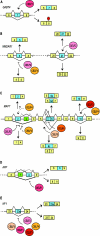CUG-BP, Elav-like family (CELF)-mediated alternative splicing regulation in the brain during health and disease
- PMID: 23247071
- PMCID: PMC3650117
- DOI: 10.1016/j.mcn.2012.12.003
CUG-BP, Elav-like family (CELF)-mediated alternative splicing regulation in the brain during health and disease
Abstract
Alternative splicing is an important mechanism for generating transcript and protein diversity. In the brain, alternative splicing is particularly prevalent, and alternative splicing factors are highly enriched. These include the six members of the CUG-BP, Elav-like family (CELF). This review summarizes what is known about the expression of different CELF proteins in the nervous system and the evidence that they are important in neural development and function. The involvement of CELF proteins in the pathogenesis of a number of neurodegenerative disorders, including myotonic dystrophy, spinocerebellar ataxia, fragile X syndrome, spinal muscular atrophy, and spinal and bulbar muscular atrophy is discussed. Finally, the known targets of CELF-mediated alternative splicing regulation in the nervous system and the functional consequences of these splicing events are reviewed. This article is part of a Special Issue entitled "RNA and splicing regulation in neurodegeneration."
Keywords: APP; Alternative splicing; Amyloid precursor protein; Brain; CELF; CLIP; CUG-BP, Elav-like family; Crosslinking immunoprecipitation; DM1; GABT4; Gamma-aminobutyric acid transporter 4; MAPT; MBNL; Microtubule-associated protein tau; Muscle blind-like; Myotonic dystrophy; Myotonic dystrophy type 1; N-methyl-d-aspartate receptor 1; NF1; NMDAR1; Neurofibromin 1; Neurological disorders; Neurons; SBMA; SCA; SMA; SMN; Spinal and bulbar muscular atrophy; Spinal muscular atrophy; Spinocerebellar ataxia; Survival motor neuron.
Copyright © 2012 Elsevier Inc. All rights reserved.
Figures

Similar articles
-
Repression of nuclear CELF activity can rescue CELF-regulated alternative splicing defects in skeletal muscle models of myotonic dystrophy.PLoS Curr. 2012 Feb 24;4:RRN1305. doi: 10.1371/currents.RRN1305. PLoS Curr. 2012. PMID: 22453899 Free PMC article.
-
Alternative splicing of the neurofibromatosis type 1 pre-mRNA is regulated by the muscleblind-like proteins and the CUG-BP and ELAV-like factors.BMC Mol Biol. 2012 Dec 10;13:35. doi: 10.1186/1471-2199-13-35. BMC Mol Biol. 2012. PMID: 23227900 Free PMC article.
-
The neurofibromatosis type I pre-mRNA is a novel target of CELF protein-mediated splicing regulation.Nucleic Acids Res. 2010 Jan;38(1):253-64. doi: 10.1093/nar/gkp766. Epub 2009 Oct 23. Nucleic Acids Res. 2010. PMID: 19854948 Free PMC article.
-
An Overview of Alternative Splicing Defects Implicated in Myotonic Dystrophy Type I.Genes (Basel). 2020 Sep 22;11(9):1109. doi: 10.3390/genes11091109. Genes (Basel). 2020. PMID: 32971903 Free PMC article. Review.
-
The importance of CELF control: molecular and biological roles of the CUG-BP, Elav-like family of RNA-binding proteins.Wiley Interdiscip Rev RNA. 2012 Jan-Feb;3(1):104-21. doi: 10.1002/wrna.107. Epub 2011 Aug 17. Wiley Interdiscip Rev RNA. 2012. PMID: 22180311 Free PMC article. Review.
Cited by
-
Splicing factors control C. elegans behavioural learning in a single neuron by producing DAF-2c receptor.Nat Commun. 2016 May 20;7:11645. doi: 10.1038/ncomms11645. Nat Commun. 2016. PMID: 27198602 Free PMC article.
-
Bruno 1/CELF regulates splicing and cytoskeleton dynamics to ensure correct sarcomere assembly in Drosophila flight muscles.PLoS Biol. 2024 Apr 29;22(4):e3002575. doi: 10.1371/journal.pbio.3002575. eCollection 2024 Apr. PLoS Biol. 2024. PMID: 38683844 Free PMC article.
-
CELFish ways to modulate mRNA decay.Biochim Biophys Acta. 2013 Jun-Jul;1829(6-7):695-707. doi: 10.1016/j.bbagrm.2013.01.001. Epub 2013 Jan 15. Biochim Biophys Acta. 2013. PMID: 23328451 Free PMC article. Review.
-
Interplay of RNA-Binding Proteins and microRNAs in Neurodegenerative Diseases.Int J Mol Sci. 2021 May 18;22(10):5292. doi: 10.3390/ijms22105292. Int J Mol Sci. 2021. PMID: 34069857 Free PMC article. Review.
-
Embryonic Stem Cell-Derived Neurons as a Model System for Epigenome Maturation during Development.Genes (Basel). 2023 Apr 22;14(5):957. doi: 10.3390/genes14050957. Genes (Basel). 2023. PMID: 37239317 Free PMC article.
References
-
- Anderson KN, Baban D, Oliver PL, Potter A, Davies KE. Expression profiling in spinal muscular atrophy reveals an RNA binding protein deficit. Neuromuscul Disord. 2004;14:711–722. - PubMed
-
- Andreadis A. Tau gene alternative splicing: expression patterns, regulation and modulation of function in normal brain and neurodegenerative diseases. Biochim Biophys Acta. 2005;1739:91–103. - PubMed
Publication types
MeSH terms
Substances
Grants and funding
LinkOut - more resources
Full Text Sources
Other Literature Sources
Medical
Research Materials
Miscellaneous

